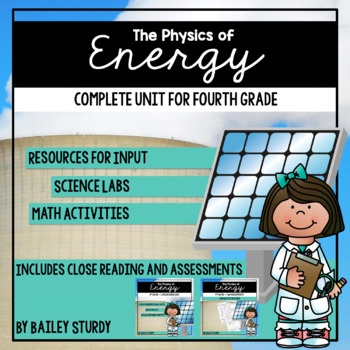4th Grade NGSS Energy Unit
- Zip
Also included in
- Save 25% by buying the bundle! This bundle includes all 4 units for fourth grade: Energy, Earth Science, Waves, and Plant and Animal Structures.In this bundle you will find:Resources for InputInquiry ChartObservation ChartsBig Book (PPT or printable)Pictorial and Comparative Input Chart templates (2Price $43.50Original Price $58.50Save $15.00
Description
This unit integrates science, reading, writing, and math to teach the 4th grade NGSS energy standards, including topics such as types of energy, energy transfer, energy conversion, and renewable/non-renewable energy sources.
Here's what's included:
Resources for Input:
- Unit EQ
- Inquiry chart printable
- Observation chart photos
- Big Book: The Important Thing about Energy (available in a printable format or PPT format)
- Sample CCD and blank printable student copy
- 7 pictorial and/or comparative input charts. Titles are:
- Types of Energy (potential vs kinetic)
- Mechanical Energy Transfer
- Energy Transfer in Collision
- Electrical Energy Transfer
- Thermal Energy Transfer
- Conductors vs Insulators
- An Electrical Circuit
- Renewable vs Non-Renewable Energy Sources
- 3 chants
- Energy Transfer and Conversion (set of 6) expert group passages with photos, mind map printable, and process grid printable. Titles are:
- Campfire
- Baseball
- Roller coaster
- Chopping wood
- Hot air balloon
- Sling shot
- Renewable Energy Sources (set of 5) expert group passages. Titles are:
- Wind
- Solar
- Hydropower
- Geothermal
- Biomass
- 2 printable sentence pattern charts and teacher sample
Writing Resources:
- Writing prompts for narrative, information, and opinion texts with writing paper
Close Reading:
- Three sets of passages with EQs (each set of passages includes a beginning, middle, and end of fourth grade leveled text. Passages are available as an article or a reader)
Titles:
- Energy Poverty // A Trip to Africa (paired texts)
- What's the Deal with Fossil Fuels?
- Thomas Edison and the Light Bulb
- Sample charts
- 3 sets of text dependent questions per passage, answer keys included
- 2 journal prompt questions per passage
These text sets also have Google Slides presentations containing the leveled text, all question sets, and the journal prompts.
Note that these are the same close readings as the ones in the Energy Close Reading and 4th Grade Close Reading Bundle.
Math Activities:
- 2 low-prep centers with answer keys (multi-digit multiplication and line plots)
- 1 booklet center (factors vs multiples)
- 1 printable math activity at two levels with answer keys (word problems)
Science Labs/PBL:
- Energy Scavenger Hunt
- Drawing Sankey Diagrams
- Build a Catapult Design Challenge
- Racecar Collisions
- Lemon Battery Demonstration
- Ice Melt Challenge
- Solar Oven Design
Art Integration
- Printable images of 6 works of art
- Discussion Starter Questions that relate the artwork to science
- 1 Art Lesson
Assessment
NOTE: These assessments are available separately here. There is no need to buy both.
- Energy assessment (19 questions)
- Energy Sources assessment (16 questions)
- Answer keys for all assessment questions
- Sample answers based on expected data are provided for the Sankey diagrams, racecar collisions, ice melt challenge labs, and solar oven reflection pages
Please see the preview for more information!






